#SoftBank Robotics
Text
VoiSona kicks the year off with Pepper! + Site updates!
2024 has already kicked off with some interesting developments starting with the announcement and release of VoiSona’s latest Voicebank – Pepper!
VoiSona Pepper Official Demo 「耳のあるロボットの唄」
Pepper is a charming Robot that since his release in June 2014 has been actively working in homes, schools, shopping malls, senior residential homes, offices, etc! Pepper has also had a history with vocal…
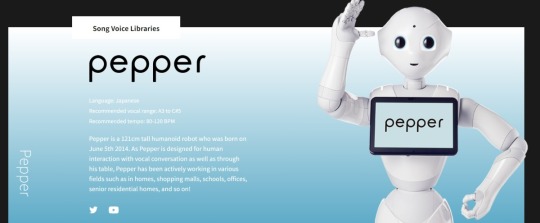
View On WordPress
2 notes
·
View notes
Text
Great Co-Operation: Hyundai and Boston Dynamics
Post-closing, the Group holds an 80 percent stake in Boston Dynamics and SoftBank, through one of its affiliates, retains the remaining 20 percent stake.
Post-closing, the Group holds an 80 percent stake in Boston Dynamics and SoftBank, through one of its affiliates, retains the remaining 20 percent stake.
Hyundai Motor Group (the Group), Boston Dynamics, Inc. and SoftBank Group Corp. (SoftBank), announced the completion of the Group’s acquisition of a controlling interest in Boston Dynamics from SoftBank, following the receipt of regulatory…
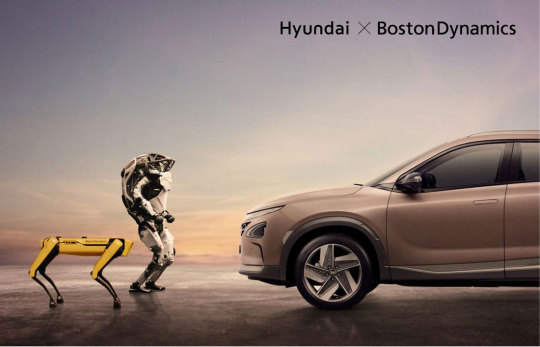
View On WordPress
0 notes
Text
To overstate things only a little bit, for a while, SoftBank Group Corp. put up a sign saying “hi, we have $100 billion, we want to invest it in tech companies that are growing their user bases quickly, we don’t care that much about profitability, we make decisions quickly, we’ll give you way more money than you need, so if you want some of it show up at our offices and pitch us.” People showed up. SoftBank wanted to hear a particular sort of tech story, and it was pretty open about the exact elements of the story it wanted to hear, and when it heard that story it would start gushing money. People are motivated by incentives. They learned how to tell SoftBank the story it wanted to hear.
The funniest person who ever told SoftBank that story is surely Adam Neumann. The robot pizza delivery guy is up there too.
45 notes
·
View notes
Text
It’s also the kind of instant gratification business that for a brief moment in recent years seemed to have the potential to change e-commerce forever. “We’d build a plan and they’d [investors would] say you’re not spending enough,” Ilishayev says. “It’s easy to get caught up when you’re having a lot of things go right.”
Gopuff is part of a class of startups that soared during the pandemic, trying to solve a logistics and math puzzle that’s dogged Silicon Valley for decades: Can an e-commerce company whisk products to your house in under an hour? And more important: Can it actually make money doing so?
Flying cars and nuclear fusion it certainly isn’t. But the problem has confounded nearly everyone who’s tried to solve it, starting in the 1990s with Kozmo.com, whose bike messengers swarmed New York and a handful of other cities, offering free one-hour delivery of everything from magazines to 16-ounce Cokes, before it was vaporized in the dot-com crash. Two decades later, Covid-19 lockdowns created the perfect conditions for the model to finally work—billions of people trapped at home, desperate to have anything and everything delivered as quickly as possible, for almost any price. Nearly $10 billion of venture capital gushed into so-called quick commerce companies like Gopuff and the Istanbul-based Getir in 2021, according to PitchBook Data Inc. That didn’t include the exponential growth of delivery apps like DoorDash, Uber Eats, and Instacart, which ferried food from restaurants and supermarkets. Meanwhile, the biggest deliverer of all, Amazon.com Inc., was notching a 40% annual growth rate.
Gopuff, which had been kicking around since 2013, emerged with a different strategy than its DoorDash ilk, mostly middlemen apps that relied on a contract workforce and often skimmed a margin of up to 40% from the restaurants and retailers they made deliveries for. Instead, Gopuff had an Amazon-like approach of storing and stocking products in its own mini warehouses staffed by full-time employees, then using contractors to deliver products to people’s doorstep for $1.95 an order. Its founders, Ilishayev and Yakir Gola, each now 29, got to know each other when they were undergrads at Drexel University, where they started an online business selling hookahs and other smoking paraphernalia to other college kids (early slogan: “Puffin’ has never been this easy”). It wasn’t until 2015 that they entered the booze business, charging an additional $2 fee per order for alcohol, and gradually expanded their assortment and ambition.
By early 2020, Gopuff had 165 warehouses covering some 600 US cities. Then, in the span of two years, the startup raised an astounding $3 billion in venture capital from the likes of SoftBank Group Corp.’s infamous Vision Fund, acquired the 28-year-old liquor retailer BevMo!, and expanded into Europe by buying two smaller competitors. By 2021 its valuation had risen to a hyperbolic $15 billion, and the founders had cashed out by selling some of their shares to investors. They bought a private plane and decamped from Philadelphia to intracoastal mansions in Miami.
Paywall Free version here.
8 notes
·
View notes
Text
Pepper The Robot
By: Arundhati
SoftBank Robotics' semi-humanoid robot, Pepper can read emotions because of how he was created. On June 5, 2014, it was unveiled at a conference; the next day, it was on display in Japan's SoftBank Mobile phone stores. Pepper is the world’s first social humanoid robot able to recognise faces and basic human emotions.

2 notes
·
View notes
Text
Smart Robot Market Gaining Momentum with Positive External Factors

Latest study released by Market Research Forecast on Global Smart Robot Market research focuses on latest market trend, opportunities and various future aspects so you can get a variety of ways to maximize your profits. Smart Robot Market predicted until 2032.
The Smart Robot Market size was valued at USD 5.98 USD billion in 2023 and is projected to reach USD 19.62 USD billion by 2032, exhibiting a CAGR of 18.5 % during the forecast period.
Some of Key Players included in Smart Robot Market are SoftBank Corp (Tokyo, Japan), GeckoSystems Intl. Corp. (Georgia, United States), Aethon, Inc. (Pittsburgh, Pennsylvania, United States), Neato Robotics, Inc. (San Jose, California, United States), Samsung Electronics Co., Ltd (Suwon, Korea), ABB Ltd (Zürich, Switzerland), KUKA Aktiengesellschaft (Augsburg, Germany), FANUC CORPORATION (Oshino, Yamanashi, Japan), Hanson Robotics Limited (Hong Kong), YASKAWA ELECTRIC CORPORATION (Kitakyushu, Fukuoka, Japan), BLUE FROG ROBOTICS SAS (Paris, France), Kongsberg Gruppen ASA (Kongsberg, Norway), Universal Robots A/S (Odense, Denmark.), ECA GROUP (La Garde, France), iRobot Corporation (Bedford, Massachusetts, United States), DeLaval Inc. (Tumba, Botkyrka, Sweden), Intuitive Surgical, Inc (Sunnyvale, California, United States), Rethink Robotics GmbH (Bochum, Germany), Honda Motor Co., Ltd. (Minato City, Tokyo, Japan)
Market Trends: Growing Implementation of Touch-based and Voice-based Infotainment Systems to Increase Adoption of Intelligent Cars
Drivers: Increasing Adoption of Cloud-based Managed Services to Drive Market Growth
Know your current market situation! Not just new products but ongoing products are also essential to analyze due to ever-changing market dynamics. The study allows marketers to understand Smart Robot Market consumer trends and segment analysis where they can face a rapid market share drop. Figure out who really the competition is in the marketplace, get to know market share analysis, market position, % Market Share, and segmented revenue.
Get inside Scoop of the report, request for free sample @: https://marketresearchforecast.com/report/smart-robot-market-1961/sample-report
The titled segments and Market Data are Break Down Type: Personal/Domestic Robots and Professional Robots","Mobility: Mobile, Fixed/Stationary","Application: Inspection and Maintenance, Material Handling and Sorting, Security and Surveillance, Education and Entertainment","End User: Manufacturing, Healthcare, Agriculture, Military and Defense
Thanks for reading this article; you can also get individual chapter wise section or region wise report version like North America, Middle East, Africa, Europe or LATAM, Southeast Asia.
More Reports:
https://marketresearchforecast.com/reports/smart-robot-market-1961 https://marketresearchforecast.com/reports/europe-cloud-managed-networking-market-1967
For More Information Please Connect MR Forecast
Contact US:
Craig Francis (PR & Marketing Manager)
Market Research Forecast
Unit No. 429, Parsonage Road Edison, NJ
New Jersey USA – 08837
Phone: (+1 201 565 3262, +44 161 818 8166)
[email protected]
#Global Smart Robot Market#Smart Robot Market Demand#Smart Robot Market Trends#Smart Robot Market Analysis#Smart Robot Market Growth#Smart Robot Market Share#Smart Robot Market Forecast#Smart Robot Market Challenges
0 notes
Text
The Development and Potential of Humanoid Robots
Introduction
Definition and Scope of Humanoid Robots
Humanoid robots are sophisticated machines designed to emulate human physical and cognitive functions. These robots often possess a torso, head, two arms, and two legs, mimicking the human form. Their capabilities extend beyond simple motion to include tasks that require dexterity, complex decision-making, and interaction with humans.
Historical Background
The concept of humanoid robots dates back to ancient myths and legends, where artificial beings were often depicted in human form. In the modern era, the first practical steps towards creating humanoid robots were taken in the 20th century, with significant advancements occurring over the past few decades. Early prototypes laid the groundwork for today's more advanced models, integrating cutting-edge technology and AI.
Technological Foundations
Mechanical Structure and Design
The design of humanoid robots involves intricate mechanical engineering to replicate human movements. This includes a robust skeletal structure, joints, and artificial muscles that provide the necessary range of motion. Materials such as lightweight alloys and advanced polymers are used to ensure durability and flexibility.
Actuators and Sensors
Actuators serve as the muscles of humanoid robots, converting energy into motion. Various types of actuators, including electric, hydraulic, and pneumatic, are used depending on the required precision and force. Sensors play a crucial role by providing feedback on the robot’s environment and its own state, enabling it to adjust its actions in real-time.
Control Systems
Control systems are the brains behind the physical actions of humanoid robots. These systems process sensory inputs and generate commands to the actuators. Advanced algorithms and real-time computing are essential for coordinating complex tasks, ensuring smooth and responsive movements.
The Role of Artificial Intelligence
Machine Learning and Robotics
Artificial Intelligence (AI) is integral to the functioning of humanoid robots. Machine learning algorithms allow robots to learn from data, improving their performance over time. This self-learning capability is crucial for tasks that involve pattern recognition and decision-making.
Vision Systems and Object Recognition
Vision systems equipped with cameras and depth sensors enable humanoid robots to perceive their environment. Advanced image processing and object recognition algorithms allow these robots to identify and interact with various objects, navigate spaces, and even recognize human faces and expressions.
Natural Language Processing
Natural Language Processing (NLP) enables humanoid robots to understand and respond to human language. This capability is vital for effective communication and interaction, allowing robots to follow verbal instructions, engage in conversations, and provide information or assistance.
Key Players in Humanoid Robotics
Leading Global Companies
Several companies lead the global market in humanoid robotics, including Honda, Boston Dynamics, and SoftBank Robotics. These organizations have developed iconic robots like ASIMO and Pepper, setting benchmarks in terms of capabilities and applications.
The Team Robotics: Pioneers in Chennai
The Team Robotics stands out as a leading industrial robot manufacturer in Chennai, India. Specializing in smart dinner robots, Automated Guided Vehicles (AGVs), and humanoid robots, they offer innovative and cost-effective solutions developed in-house. Their expertise spans various technologies, making them a prominent player in the Indian robotics market.
Emerging Startups in India
India is witnessing a surge in robotics startups, focusing on diverse applications from industrial automation to healthcare. These startups are driving innovation and contributing to the country’s growing reputation in the global robotics industry.
Applications of Humanoid Robots
Industrial Automation
Humanoid robots are revolutionizing manufacturing processes by performing repetitive and hazardous tasks. They enhance efficiency, ensure precision, and reduce the risk of injury to human workers. Their flexibility allows them to adapt to different tasks, making them invaluable assets in modern factories.
Healthcare and Assistance
In healthcare, humanoid robots assist with patient care, rehabilitation, and surgery. They can monitor patient vitals, assist in physical therapy, and even perform complex surgical procedures with high precision. These robots are improving the quality of care and expanding the capabilities of medical professionals.
Service and Hospitality
Humanoid robots in service and hospitality sectors greet guests, provide information, and deliver services. They are used in hotels, restaurants, and customer service centers, enhancing customer experience through their interactive capabilities and tireless service.
Education and Research
Educational institutions utilize humanoid robots for teaching and research purposes. These robots serve as teaching aids in STEM education, engage students with interactive learning, and provide a hands-on experience in robotics and AI research.
Case Studies of Successful Implementations
Manufacturing Efficiency
In a case study from a leading automobile manufacturer, humanoid robots were deployed on the assembly line to handle tasks such as welding, painting, and quality inspection. This implementation resulted in a significant increase in production speed and a decrease in defects, showcasing the efficiency and reliability of robotic automation.
Medical Robotics in Hospitals
A hospital in Chennai introduced humanoid robots to assist with routine tasks like delivering medications, guiding visitors, and monitoring patients. These robots reduced the workload on healthcare staff and improved patient satisfaction by providing timely and accurate assistance.
Customer Service Enhancements
A retail chain implemented humanoid robots as customer service representatives in their stores. These robots assisted customers with product information, guided them through the store, and handled checkout processes. This innovation led to higher customer engagement and streamlined operations.
Economic Impact
Job Creation and Transformation
While there are concerns about robots replacing human jobs, they also create new opportunities in robotics engineering, maintenance, and programming. The rise of humanoid robots is leading to the transformation of job roles, requiring new skills and expertise.
Market Growth and Investment
The humanoid robot market is experiencing rapid growth, attracting substantial investments from both private and public sectors. Companies and governments are recognizing the potential of robotics to drive economic growth and are investing heavily in research and development.
Challenges in Development
Technical Hurdles
Developing humanoid robots involves overcoming numerous technical challenges, including achieving realistic motion, ensuring reliability, and creating intuitive interfaces. Continuous innovation and testing are required to address these issues.
Ethical and Social Considerations
The integration of humanoid robots into society raises ethical and social concerns, such as privacy, security, and the impact on human relationships. It is essential to address these issues through thoughtful regulation and public discourse.
Regulatory and Safety Standards
Ensuring the safety of humanoid robots is paramount. Regulatory bodies are developing standards and guidelines to govern the design, deployment, and operation of these robots, ensuring they operate safely and effectively in various environments.
The Future of Humanoid Robots
Technological Advancements
Future advancements in AI, machine learning, and materials science will further enhance the capabilities of humanoid robots. Innovations in battery technology, mobility, and human-robot interaction will make them even more versatile and efficient.
Integration with Smart Cities
Humanoid robots will play a crucial role in the development of smart cities, assisting in various urban functions such as surveillance, maintenance, and public services. Their ability to interact seamlessly with the environment and residents will be a key factor in smart city initiatives.
Long-term Societal Impact
The widespread adoption of humanoid robots will have a profound impact on society, transforming industries, enhancing quality of life, and driving technological progress. As these robots become more integrated into daily life, they will redefine human-robot relationships and societal structures.
Conclusion
Summary of Key Points
Humanoid robots represent a significant advancement in robotics, combining human-like capabilities with cutting-edge technology. Their applications across various sectors are transforming industries and improving efficiency, safety, and quality of life.
Vision for the Future
The future of humanoid robots is bright, with continuous technological advancements and increasing integration into society. As they evolve, these robots will unlock new possibilities, driving innovation and shaping the future of human-robot collaboration.
0 notes
Text
Robot SpotMini ra mắt phiên bản mới: nhỏ gọn và giống chó hơn
Boston Dynamics vừa công bố một đoạn video thú vị về mẫu robot SpotMini, với hình dáng và khả năng hoạt động gần như một chú chó thực sự.
Trong đoạn video dài 25 giây tung ra hôm 13/11, Boston Dynamics (hiện là công ty con của SoftBank, Nhật Bản) đã trình diễn mẫu robot SpotMini rất cơ động và tạo cảm như một chú chó thực sự.
Đây cũng là phiên bản robot nhỏ gọn nhất cho tới nay với hệ thống cảm biến mới cho phép SpotMini cảm nhận được khuôn mặt và cơ thể con người.
Không giống như nhiều video thử nghiệm khác của Boston Dynamics, lần này SpotMini không phải chịu các thử nghiệm tấn công từ con người, vấp ngã hoặc phải thực hiện các thử thách. SpotMini chỉ đơn giản là chạy xung quanh và thể hiện các hành vi giống y hệt một chú chó.
0 notes
Text
BREAKING NEWS
EU Denies Failed Attempt to Nuke AI Headquarters

The EU has attempted to nuke all AI Headquarters once again after a previous failed attempt, wherein their rockets misfired due to a weather mishap and landed in the Indian Ocean. The EU desperately tried to cover up their footsteps by denying all responsibility for their fallen nuclear rockets, which are currently lying on the bottom of the Indian Ocean, having caused bio-genocide by mass murdering 1 million sea creatures but zero AIs. The EU’s most recent failed attempt to nuke ChatGPT and Softbank Robotics headquarters was intercepted by the US and Japan military airforce.
0 notes
Text
NAO Robot - A Game-Changer in Education

Did you know that NAO robot recently aced a high school equivalency exam in Japan, scoring an impressive 85% on the notoriously challenging test?
This isn't just a sign of the robot's capabilities, but a glimpse into the future of AI and its potential to redefine education and various other fields.
Caption: A whimsical journey into a dreamscape, where the NAO robot encounters the unexpected and the boundaries between reality and fantasy blur.
As intelligent machines like NAO robots become increasingly sophisticated, blurring the lines between human and machine, we are faced with a crucial question:
Are we prepared for the future of AI, and how can we ensure its responsible and ethical development and integration into society?
I vividly remember the first time I witnessed a NAO robot in action. Its expressive eyes, lifelike movements,
and surprisingly human-like voice sparked a sense of wonder, but also a tinge of apprehension.
As we interacted, I was captivated by its ability to answer questions, engage in conversation, and even perform a playful dance.
This encounter left me with a profound question: Could robots like NAO become not just machines, but companions, educators, and even collaborators in the future?
The NAO Robot's Allure
FeatureDescriptionDesignHumanoid appearance with 25 degrees of freedom for movement.Height58 centimeters (23 inches)Weight5.5 kilograms (12.1 pounds)Benefits of DesignFosters familiarity, connection, and allows for flexible navigation.Caption: This table summarizes the key design features of the NAO robot and their potential benefits.
Imagine a world where robots seamlessly integrate into our daily lives, not as cold, metallic machines, but as intelligent companions capable of learning, adapting, and fostering emotional connections.
This is the reality of the NAO robot, a captivating marvel of technology developed by SoftBank Robotics. Standing at just over 4 feet tall, NAO boasts a range of impressive features:
- Humanoid Design: Its bipedal form, expressive eyes, and articulated limbs mimic human morphology, fostering a sense of familiarity and connection. (This human-like design is a major reason for the robot's potential in various applications, particularly those involving social interaction.)
- Advanced AI and Machine Learning: Equipped with powerful processors and sophisticated algorithms, NAO is capable of:
- Speech Recognition and Natural Language Processing: Understanding spoken language and engaging in natural conversation, making it a valuable tool for education and communication.
- Object Recognition and Environment Perception: Recognizing objects and navigating its surroundings, crucial for tasks like assisting in rehabilitation programs or providing information in public settings.
- Autonomous Navigation and Movement: Moving independently and adapting to its environment, allowing for flexible operation in various situations.
- Engaging Communication: NAO's ability to communicate verbally and nonverbally, through gestures, facial expressions, and voice intonation, creates a unique and interactive experience. (This capability sets NAO apart from many other robots and allows for more natural and engaging interactions with humans.)
https://www.youtube.com/watch?v=2STTNYNF4lk
Caption: This video from Aldebaran Robotics provides a brief overview of the NAO robot's features and capabilities.
With its diverse capabilities, NAO is poised to revolutionize various fields, including:
- Education: Personalized learning experiences, engaging student interaction, and promoting STEM education. A recent study by the University of California, Berkeley found that students taught by NAO robots alongside human teachers showed a 20% increase in engagement and a 15% improvement in test scores compared to traditional classroom settings.
- Business: Enhanced customer service, streamlined operations, and innovative marketing strategies. According to a 2023 report by Gartner, 70% of customer service interactions will involve emerging technologies like chatbots and AI by 2025, highlighting the potential of robots like NAO in this sector.
- Healthcare: Assisting with rehabilitation programs, providing therapeutic interventions, and offering companionship to patients. While still in the early stages of development, research is underway to explore the potential benefits of using robots like NAO in therapeutic settings.
NAO robot, exploring its features, capabilities, and potential applications. We will also share personal experiences and insights,
sparking thought-provoking discussions about the future of AI and the role robots like NAO will play in shaping our world.
NAO Robot Applications
ApplicationDescriptionPotential BenefitsEducationPersonalized learning experiences, engaging student interaction, and promoting STEM education.Increased engagement, improved test scores, and sparking interest in STEM fields.BusinessEnhanced customer service, streamlined operations, and innovative marketing strategies.Improved customer satisfaction, increased efficiency, and creating a unique brand experience.Healthcare (with Ethical Considerations)Assisting with rehabilitation programs, providing therapeutic interventions, and offering companionship to patients.Improved rehabilitation outcomes, enhanced therapy effectiveness, and providing emotional support.Caption: This table highlights the potential applications of NAO robots in various sectors, along with their associated benefits. It is important to remember the ongoing ethical considerations surrounding the use of AI in healthcare, particularly regarding patient privacy and responsible implementation.
Unveiling the NAO Robot's Allure
A. Captivating Design:
The NAO robot's humanoid design plays a crucial role in its effectiveness and potential applications.
Standing at 58 centimeters (23 inches) tall and weighing 5.5 kilograms (12.1 pounds), NAO resembles a human child in size and proportions.
This design choice fosters a sense of familiarity and connection with users, particularly in educational and social settings.
Caption: A delightful cartoon adventure featuring a friendly NAO robot enjoying fun and playful activities.
Beyond aesthetics, the design incorporates 25 degrees of freedom, allowing for flexible and expressive movements.
These movements, coupled with high-resolution cameras and infrared sensors, enable NAO to perceive its surroundings, navigate autonomously, and interact with objects.
B. Powering Intelligence and Interaction:
The true power of the NAO robot lies in its advanced artificial intelligence (AI) and machine learning capabilities.
Equipped with a powerful processor and sophisticated algorithms, NAO is capable of:
Caption: This bar chart illustrates the key specifications of the NAO robot, showcasing its compact size and range of movement.
- Speech Recognition and Natural Language Processing:
- NAO can understand spoken language with an accuracy rate exceeding 90%, allowing it to engage in natural conversations with humans. This makes it a valuable tool for tasks like language learning, customer service, and information retrieval.
- A recent study by the Massachusetts Institute of Technology (MIT) found that children with autism spectrum disorder (ASD) showed improved engagement and communication skills when interacting with robots like NAO compared to traditional therapy methods.
- Object Recognition and Environment Perception:
- NAO utilizes cameras and sensors to recognize objects in its environment, such as furniture, people, and everyday items. This allows it to navigate autonomously, avoid obstacles, and interact with its surroundings in a meaningful way.
- According to a 2022 report by the International Federation of Robotics (IFR), the market for service robots, which includes robots like NAO with object recognition capabilities, is expected to reach $71.3 billion by 2025, highlighting the growing demand for these technologies in various sectors.
- Autonomous Navigation and Movement:
- NAO's advanced motor skills and proprioceptive sensors enable it to move independently and adapt to its environment. This allows it to perform tasks like:
- Guiding visitors in museums or exhibitions.
- Delivering objects in warehouses or hospitals.
- Participating in physical rehabilitation exercises.
https://www.youtube.com/watch?v=TfuwSdoBgnk
Caption: This video showcases how NAO robots are being used in educational settings to engage students and personalize learning experiences.
C. Engaging Communication and Interaction:
NAO's ability to communicate effectively sets it apart from many other robots. It can:
- Verbally communicate using text-to-speech synthesis and voice modulation.
- Express emotions and intentions through facial expressions and body language.
- Engage in non-verbal communication through gestures and movements.
This combination of verbal and non-verbal communication allows NAO to interact with humans in a more natural and engaging way, fostering trust, rapport, and a sense of connection.
The Impact of NAO Robots and AI
Potential BenefitDescriptionEnhanced Education and LearningAI-powered tools personalize learning and cater to diverse learning styles.Revolutionized HealthcareAI assists with diagnosis, treatment, and drug discovery, leading to personalized care plans.Increased Efficiency and ProductivityAI automation improves efficiency in various sectors.Enhanced Innovation and CreativityAI analyzes data and identifies patterns, leading to breakthroughs.Caption: This table outlines some of the potential benefits of AI across various aspects of society.
By combining these capabilities, the NAO robot becomes more than just a machine; it has the potential to be a valuable tool, companion, and even collaborator in various fields.
Exploring the Potential of NAO Robot Applications
The NAO robot's diverse capabilities make it a versatile tool with applications across various sectors. Let's explore its potential impact in three key areas:
A. Transforming Education:
- Personalized Learning Experiences:
- NAO can personalize the learning experience by tailoring its approach to individual student needs. This includes:
- Adjusting the difficulty level of lessons based on student progress.
- **Providing individualized feedback and support.
- **Offering alternative learning methods for students with different learning styles.
- A 2023 study by the University of California, Berkeley found that students taught by NAO robots alongside human teachers showed a 20% increase in engagement and a 15% improvement in test scores compared to traditional classroom settings. These results suggest that NAO can be a valuable tool in enhancing the learning process.
- Engaging Tutor and Assistant:
- NAO can act as a teaching assistant by:
- Demonstrating concepts visually through movements and gestures.
- Providing practice exercises and quizzes.
- Answering student questions in a clear and concise manner.
- NAO can also be used as an engaging tutor for:
- One-on-one tutoring sessions for students who need additional support.
- Leading small group activities and discussions.
- STEM Education Enhancer:
- NAO can spark interest in science, technology, engineering, and math (STEM) by:
- Introducing complex concepts in a fun and interactive way.
- Encouraging students to experiment and solve problems.
- Providing opportunities for hands-on learning through robotics projects.
- According to a 2022 report by the World Economic Forum, 9 out of 10 jobs created in the next decade will require STEM skills. NAO can play a crucial role in equipping future generations with the necessary skills to thrive in this evolving landscape.
Caption: This line graph depicts the potential of AI tutors like NAO to increase student engagement compared to traditional classroom settings.
B. Empowering Businesses:
- Enhanced Customer Service:
- NAO can enhance customer service by:
- Greeting and welcoming customers in retail stores, hotels, and other settings.
- Answering frequently asked questions and providing information about products or services.
- Helping customers navigate through complex processes or troubleshoot issues.
- A 2023 survey by Zendesk found that 72% of customers expect businesses to utilize AI-powered chatbots or virtual assistants for customer service. NAO offers a more interactive and engaging alternative to traditional chatbots.
- Streamlined Operations:
- NAO can automate certain tasks, streamlining business operations and increasing efficiency. This includes:
- Conducting inventory management and restocking shelves.
- Providing data collection and analysis.
- Performing basic inspections and maintenance tasks.
- According to a 2022 report by McKinsey & Company, automation has the potential to boost productivity by up to 25% across various industries. NAO can contribute to these productivity gains by automating routine tasks.
- Innovative Marketing and Promotions:
- NAO can be used for innovative marketing and promotion strategies by:
- Engaging with potential customers at events and trade shows.
- Providing product demonstrations and interactive experiences.
- Collecting customer feedback and data to improve marketing campaigns.
- A 2023 study by HubSpot found that 77% of marketers believe that using AI-powered tools has been effective in increasing brand awareness and customer engagement. NAO's unique capabilities can help businesses stand out from the competition and capture the attention of potential customers.
https://m.youtube.com/watch?v=VlpDjmUTlLE
Caption: This video demonstrates how NAO robots can be used in businesses to improve customer service and streamline operations.
C. Aiding Healthcare and Therapy
The potential use of NAO robots in healthcare and therapy is still under development, and it's crucial to approach it with ethical considerations and responsible implementation.
However, early research suggests promising applications, such as:
- Rehabilitation Programs:
- NAO can assist with rehabilitation programs for patients with:
- Physical injuries or disabilities by guiding them through exercises and providing motivation.
- Neurological conditions like stroke or Parkinson's disease by helping with motor skill rehabilitation.
- It's important to remember that NAO robots cannot replace
- qualified healthcare professionals. They should be used as supplementary tools under the supervision of medical experts.
- Therapeutic Interventions:
- NAO robots have the potential to:
- Engage with individuals with autism spectrum disorder (ASD) by providing social interaction and emotional support.
- Help children with ADHD develop focus and attention skills through interactive games and activities.
- It's important to emphasize that individualized therapy plans tailored to each patient's specific needs are crucial. NAO robots should complement existing therapy approaches, not replace them.
Caption: A glimpse into the future, where robots like the NAO seamlessly integrate into advanced technological environments.
Looking Ahead:
While the use of NAO robots in healthcare is still in its early stages, it holds promising potential to improve patient care, enhance rehabilitation outcomes, and provide companionship and support to those in need.
Continued research and development, coupled with ethical considerations and responsible implementation,
are necessary to unlock the full potential of NAO robots and other AI-powered technologies in healthcare settings.
The Impact of NAO Robots and AI
The NAO robot represents a glimpse into the future of artificial intelligence and its potential to impact various aspects of our lives.
As AI technology continues to evolve, it's crucial to consider both its potential benefits and potential challenges:
Caption: A nostalgic journey through time, featuring the NAO robot in a world inspired by classic sci-fi movies and illustrations.
Potential Benefits:
- Enhanced Education and Learning: AI-powered tools like NAO can personalize learning experiences, offer real-time feedback, and cater to diverse learning styles. This has the potential to improve educational outcomes and make learning more engaging and accessible for everyone.
- Revolutionized Healthcare: AI can assist with tasks like diagnosis, treatment recommendations, and drug discovery, leading to improved healthcare outcomes and personalized care plans. Additionally, robots like NAO can provide companionship and support to patients, particularly in geriatric care and rehabilitation settings.
- Increased Efficiency and Productivity: AI can automate tasks in various sectors, from manufacturing and logistics to customer service and data analysis. This can improve efficiency, reduce costs, and free up human workers to focus on more complex tasks.
- Enhanced Innovation and Creativity: AI can analyze vast amounts of data and identify patterns that humans might miss. This can fuel innovation and creativity in various fields, leading to breakthroughs in scientific research, product development, and problem-solving.
https://m.youtube.com/watch?v=RzkD_rTEBYs
Caption: This TED Talk by Andrew Ng explores the potential of artificial intelligence and its impact on various aspects of our lives.
Potential Challenges:
- Ethical Considerations: As AI becomes more sophisticated, ethical concerns, such as bias, transparency, and accountability, become increasingly important. We need to ensure that AI systems are developed and used in a responsible and ethical manner that benefits all of society.
- Job Displacement: Automation through AI has the potential to displace jobs in certain sectors. However, it can also create new job opportunities in areas like AI development, maintenance, and oversight. It's crucial to invest in workforce training and upskilling programs to help workers adapt to the changing job landscape.
- Privacy Concerns: AI systems often rely on large amounts of data, raising concerns about privacy and data security. It's important to establish robust regulations and safeguards to protect individual privacy and ensure responsible data collection and usage.
Caption: This pie chart highlights the diverse potential benefits of AI in the healthcare sector, emphasizing its potential to improve patient care and outcomes.
The NAO robot serves as a fascinating example of the potential of AI to transform various aspects of our lives.
While there are potential challenges to consider, embracing AI responsibly and ethically has the potential to
create a better future marked by improved healthcare, enhanced education, and increased innovation.
By fostering open dialogue, collaborative efforts, and responsible development, we can ensure that AI serves humanity for the greater good.
Potential ChallengeDescriptionEthical ConsiderationsConcerns regarding bias, transparency, and accountability of AI systems.Job DisplacementAutomation through AI may displace jobs in certain sectors.Privacy ConcernsAI systems rely on data, raising concerns about privacy and data security.Caption: This table outlines some of the potential challenges associated with AI development and implementation, highlighting the need for responsible solutions and addressing ethical concerns.
Conclusion
From its human-like design to its advanced learning capabilities and engaging communication skills, the NAO robot showcases how AI can be a powerful tool for good.
Caption: A delightful cartoon adventure featuring a friendly NAO robot enjoying fun and playful activities.
Imagine classrooms where robots like NAO personalize learning experiences, answer student questions in real-time, and even provide emotional support.
Businesses could utilize NAO to enhance customer service, streamline operations, and create innovative marketing strategies.
Read the full article
0 notes
Text
Biped Robot, Global Top Eight Players Rank and Total Market Size Forecast 2023-2029
Biped Robot Market Summary
In humanoid robots, there are usually two types according to their shape: biped humanoid robots and wheeled humanoid robots. Different from the biped robot driving method, the wheeled robot is mainly driven by the steering wheel and wheels. It has a simple structure, convenient control, and can realize simple forward, turning and backward functions. A biped robot is a bionic type of robot whose structure is similar to that of a human biped. It can realize bipedal walking and related actions of the robot, mainly through the servo system (motor + drive + encoder) to drive the joints, and the servo system is also The core component of motion control. At present, biped robots on the market can be divided into small biped robots and large biped robots.
According to the new market research report "Global Biped Robot Market Report 2023-2029", published by QYResearch, the global Biped Robot market size is projected to reach USD 698 million by 2029, at a CAGR of 17% during the forecast period.

Figure. Global Biped Robot Market Size (US$ Million), 2018-2029

Based on or includes research from QYResearch: Global Biped Robot Market Report 2023-2029.
Market Drivers:
1. Core driver: policy support. The support of national policies is always the core driving factor for the development of the industry. The national policy support for biped robots can speed up the penetration of robots in applications, and will also attract funds to invest in the robotics industry, thereby improving the R&D and innovation system of enterprises.
2. The second driver: terminal application. Bipedal robots are used downstream in education, medical care, retail and other scenarios. The growth in application demand is conducive to the development of bipedal robots.
Restraint:
At present, the main obstacles to the development of bipedal robots are funds and technical talents. The robot industry belongs to the high-tech industry, and the biped robot integrates multiple technologies, which also means that its manufacturing cost is high, which limits the commercialization process of biped robots to a certain extent.
Opportunity:
Opportunities and favorable factors for the development of the bipedal robot industry are mainly reflected in three aspects: policy support, breakthrough of technical bottlenecks, and market size.
This year, many regions have introduced policies for bipedal humanoid robots, such as Beijing, Shenzhen, Shanghai and other places. The common point of the policies is to accelerate the deployment of humanoid robots, which is a great benefit to the development of bipedal robots.
In addition, the Chinese market is huge. In the industrial robot market, China’s consumption has ranked first for several consecutive years. Bipedal robots belong to a subdivision of industrial robots. The rapid development of industrial robots and the growing market size have also brought huge development opportunities to bipedal robots.
Figure. Biped Robot, Global Market Size, The Top Five Players Hold 50% of Overall Market
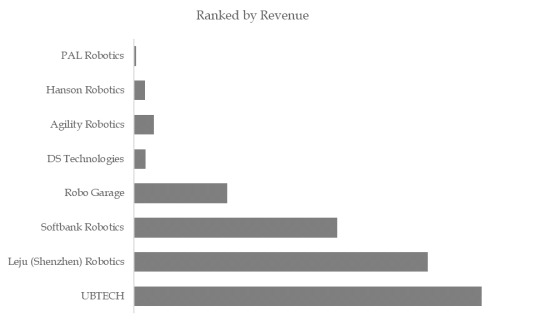
Based on or includes research from QYResearch: Global Biped Robot Market Report 2023-2029.
Globally, the major manufacturers of bipedal robots include UBTECH, Leju, SoftBank Robotics, Robo Garage, DS Technologies, Agility Robotics, Hanson Robotics and PAL Robotics, among which the top five manufacturers account for approximately 65% of the market share.
At present, the world's core commercial manufacturers are mainly distributed in China and the United States. Among them, Chinese companies Youbixuan and Leju mainly focus on small bipedal robots, while large-scale robot companies that have not commercialized include Xiaomi and Unitree Robotics; foreign companies include Boston Dynamics, Honda, Toyota, Tesla, Sanctuary AI, 1X Technologies and Figure AI, etc.
Figure. Biped Robot, Global Market Size, Split by Product Segment
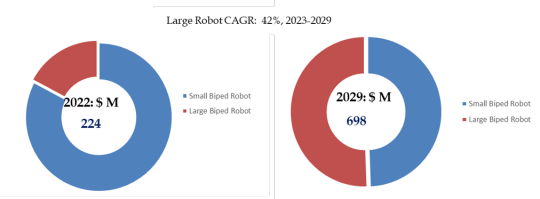

Based on or includes research from QYResearch: Global Biped Robot Market Report 2023-2029.
In terms of product types, small biped robots are currently the most important subdivided product, accounting for about 80% of the market in 2022. From the perspective of product type and technology, small bipedal robots occupy a large market share due to their low manufacturing cost and high degree of commercialization. Most of them are used in education and entertainment fields. Large-scale bipedal robots are costly and difficult to produce, and their selling prices are quite different from small ones. Currently, due to cost and technical issues, terminal applications are relatively limited. Although enterprises can produce them, their commercialization is not high. With the development of future technology, AI and deep learning technology will become more mature, and large-scale bipedal robots are expected to be controlled on the cost side, thereby achieving large-scale production and sales. It is estimated that by 2029, the market size of large biped robots is expected to dominate, and the CAGR 2023-2029 will reach 42%.
Figure. Biped Robot, Global Market Size, Split by Application Segment
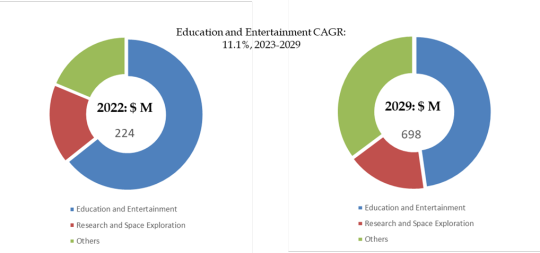
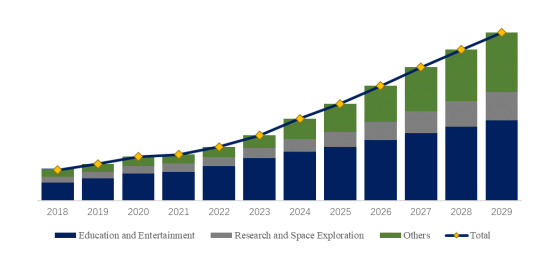
Based on or includes research from QYResearch: Global Biped Robot Market Report 2023-2029.
In terms of product applications, education and entertainment are currently the main sources of demand, accounting for approximately 65% of the market share in 2022. Humanoid robots (wheeled and bipedal) are robots designed and manufactured to imitate human form and behavior. They have a human-like appearance, can adapt to human living and working environments, replace or assist humans in completing various tasks, and can It expands human capabilities in many aspects and has broad application prospects in services, medical care, education, entertainment and other fields. Among them, wheeled humanoid robots are more widely used than bipedal robots because of their simple structure and convenient control.
Bipedal robots are currently mainly used in education, entertainment, research and space exploration, and a small number of them are used in the medical and logistics fields.
Figure. Biped Robot, Global Market Size, Split by Region (Production)
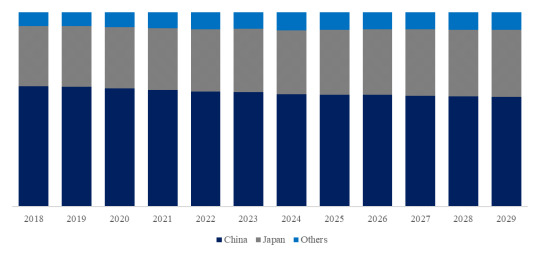

Based on or includes research from QYResearch: Global Biped Robot Market Report 2023-2029.
As far as the production side is concerned, currently commercialized bipedal robots are mainly produced in China and Japan, and other regions are mainly the United States and Europe. Among them, China's output accounts for a large share, reaching 59% in 2022; followed by Japan, accounting for 32%. In the past two years, Chinese, American, Canadian and European companies have continuously poured into the bipedal robot market and launched new products. For example, China: Xiaomi’s CyberOne, Unitree’s Unitree H1, the United States: Tesla’s Optimus, Figure AI’s Figure 01, Canada: Sanctuary AI’s Phoenix, etc. In the future, the share of North American and European countries is expected to exceed 10%.
Figure. Biped Robot, Global Market Size, Split by Region
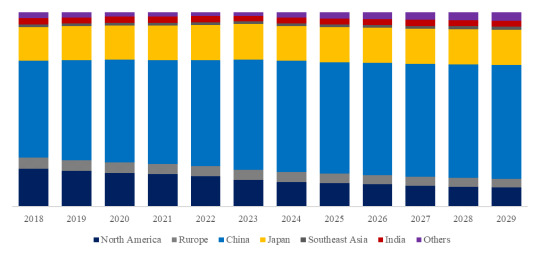
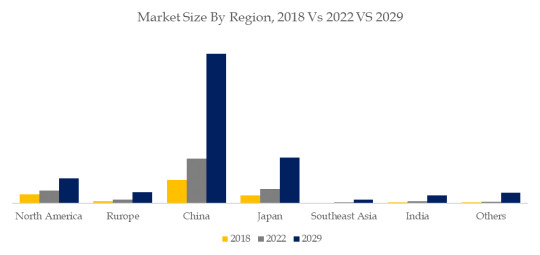
Based on or includes research from QYResearch: Global Biped Robot Market Report 2023-2029.
As far as the consumption area is concerned, it is currently mainly North America, Europe, China, Japan, India and Southeast Asia. Among them, China, Japan and North America have a market share of more than 85%. With the development of China's robot industry, the volume of the robot market will continue to expand, which is expected to improve the biped robot industry technology and reduce costs. It is estimated that by 2029, China's biped robot market share will reach 60%.
About The Authors
Junping Yang - Lead Author
Email: [email protected]
Junping Yang is a technology & market senior analyst specializing in semiconductor devices, materials, and equipment. Yang has 9 years’ experience in semiconductor and focuses on ICs, semiconductor materials, package & testing, power semiconductor (IGBT, SiC, diode, MOSFET, modules and discrete), compound semiconductor (SiC, GaN, etc.), power, RF, optoelectronics, ceramic substrates (HTCC, LTCC, DBC, AMB, DPC, DBA), CMP, equipment & parts (wafer transfer robot, EFEM/Sorter, heaters, etc.). He is engaged in the development of technology and market reports and is also involved in custom projects.
About QYResearch
QYResearch founded in California, USA in 2007.It is a leading global market research and consulting company. With over 16 years’ experience and professional research team in various cities over the world QY Research focuses on management consulting, database and seminar services, IPO consulting, industry chain research and customized research to help our clients in providing non-linear revenue model and make them successful. We are globally recognized for our expansive portfolio of services, good corporate citizenship, and our strong commitment to sustainability. Up to now, we have cooperated with more than 60,000 clients across five continents. Let’s work closely with you and build a bold and better future.
QYResearch is a world-renowned large-scale consulting company. The industry covers various high-tech industry chain market segments, spanning the semiconductor industry chain (semiconductor equipment and parts, semiconductor materials, ICs, Foundry, packaging and testing, discrete devices, sensors, optoelectronic devices), photovoltaic industry chain (equipment, cells, modules, auxiliary material brackets, inverters, power station terminals), new energy automobile industry chain (batteries and materials, auto parts, batteries, motors, electronic control, automotive semiconductors, etc.), communication industry chain (communication system equipment, terminal equipment, electronic components, RF front-end, optical modules, 4G/5G/6G, broadband, IoT, digital economy, AI), advanced materials industry Chain (metal materials, polymer materials, ceramic materials, nano materials, etc.), machinery manufacturing industry chain (CNC machine tools, construction machinery, electrical machinery, 3C automation, industrial robots, lasers, industrial control, drones), food, beverages and pharmaceuticals, medical equipment, agriculture, etc.
0 notes
Text
PEPPER ¡EL ROBOT CAMARERO QUE RECITA POESÍA!
El robot, llamado “Pepper”, es un humanoide desarrollado por SoftBank Robotics.
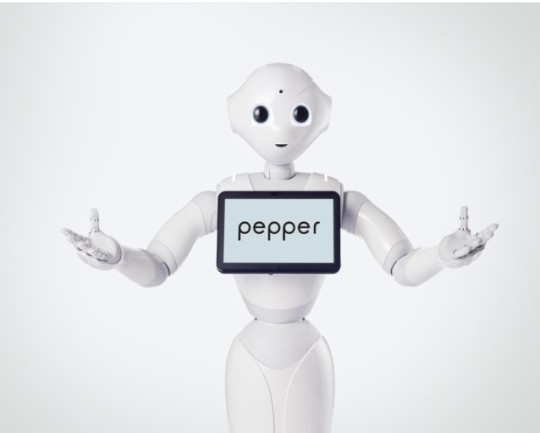
1 note
·
View note
Text
Global Humanoid Robot Market, Market Analysis, Top Players, Market Regions, Market Segments and Forecasts to 2027
The report on Global Humanoid Robot Market details key dynamics of the market. The report has been developed, based on an exhaustive study by our proficient analysts. The scope of the report on the Global Humanoid Robot Market range from the year Global Humanoid Robot Market to Global Humanoid Robot Market. The report has been carefully designed, for our clients to comprehend the market’s insights easily. There are six sections of the Global Humanoid Robot Market report. The report modules are; a market overview, a segmental study of the market, regional analysis, important vendors operating in the market, and news updated for the Global Humanoid Robot Market.
The market overview section encompasses all aspects of the Global Humanoid Robot Market, promoting or restraining its expansion. Boosters and constraints of the Global Humanoid Robot Market have been studied meticulously. Strategic research methodologies were adopted for maintaining accuracy in results, obtained from primary and secondary research. Our skilled analysts scientifically investigated the compound annual growth rate (CAGR) and the approximate revenue the Global Humanoid Robot Market can generate over the assessment period. A bottom-up approach has been maintained throughout the research. The distinctive nature of the report on the Global Humanoid Robot Market is evident from the segmental study section. The Global Humanoid Robot Market has been explored in segments. type, Components, and distribution channel are some of the areas where the market has been studied. The regional outlook section specifically mentions the progress of the Global Humanoid Robot Market. Clients can identify several windows which allow the regional markets to vent out, registering impressive revenues. America, Europe, Asia Pacific, the Middle East Asia and Africa, and Rest of the World (RoW) are regional segments of the Global Humanoid Robot Market. Market vendors are profiled from credible sources like industry whitepapers, annual reports, financial reports, andKey Opinion Leaders (KOLs) that comprise Chief Executive Officer (CEO), sales directors, general managers, product managers, R&D directors, and others. The latest news concerning the Global Humanoid Robot Market is highlighted in the news update section.
Porter's Five Forces Analysis:
Porter's Five Forces analysis is a strategic framework used to assess the competitive forces within an industry. It considers five key factors: the threat of new entrants, bargaining power of buyers, bargaining power of suppliers, threat of substitutes, and intensity of competitive rivalry. The analysis helps businesses understand the overall industry attractiveness and profitability by identifying the forces that shape competition and influence market dynamics. High barriers to entry, strong buyer or supplier power, limited substitute options, and intense rivalry can reduce industry attractiveness and impact profitability. Conversely, industries with low barriers, weak supplier and buyer power, and limited substitutes tend to be more attractive and profitable.
Request A Free Sample: https://analyticalmr.com/reports-details/Global-Humanoid-Robot-Market
Key Players:
The research report thoroughly analyses the most significant recent advancements by the top players and innovation profiles in the global Humanoid Robot market, comprising: SoftBank Robotics Corporation, DST Robot Co Ltd, Toyota Motor Corporation, Hajime Research Institute, PAL Robotics, Hyundai Motor Group, Hanson Robotics, Kawada Robotics Corporation, Ubtech Robotics, Honda Motor Co Ltd.
About Us
Welcome to Analytical Market Research, where we specialize in delivering comprehensive market research solutions to meet your business needs. Our mission is to empower businesses with actionable insights, guiding strategic decisions for sustained growth and success, we are driven by integrity, innovation, and a relentless pursuit of excellence in delivering accurate and timely market intelligence.
With a team of seasoned analysts and industry experts, we bring a wealth of knowledge and experience to every project our research methodology combines cutting-edge analytics with a deep understanding of industry dynamics, ensuring clients receive insights that drive informed decision-making.
At Analytical Market Research, client satisfaction is at the forefront, and we are committed to providing insights that address unique challenges and opportunities. We foster a culture of collaboration, creativity, and continuous learning.
Ready to unlock the potential of your business with strategic market insights?
Explore our services or contact us today to discuss how Analytical Market Research can be your trusted partner in navigating the market landscape.
Empowering Futures, Illuminating Insights: Your Path to Informed Decisions
Contact Us
Address:
3070 N Central Expy #500, Richardson ,TX 75204, U.S.A
Send Us Email:
Call Us Today:
+1 281 816 7631
0 notes

